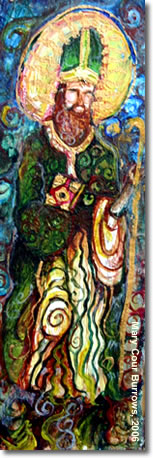Saint Patrick
387-461
Missionary, Teacher, Writer
 There was a moment recently at a religious conference when I was standing with a group of people who shared my same interests. We were holding the same books, using the same language, and I felt at home.
There was a moment recently at a religious conference when I was standing with a group of people who shared my same interests. We were holding the same books, using the same language, and I felt at home.
On the other side of the room was an entirely different group. Their words and ways were different, and I knew from past experiences with similar groups that there lay a danger of conflict and rejection. Yet I had a compelling desire to go to the other side and share something wonderful that I had received. I knew I could express it in ways that they would understand. In that moment I felt something akin to the spirit and calling of St. Patrick, and sharing his desire and boldness, I surprised myself by walking across the room to the other group.
It’s not always easy to explain the mystery of kinship with saints and soulfriends we’ve never met. All I know is that in spiritual companionship, we have treasures that transcend time and place. For me, the experience in that room gave me a glimpse into the vocation of St. Patrick and his words of amazement seemed to reflect what I was feeling as I stood between the groups.
I don’t know, God knows
Whether it was in me or beside me…
The one who gave his life for you,
he it is who speaks in you. 1
Like all words of faith, these words come alive in the context of a story. Patrick’s story is compelling, transforming and powerful. Colorful legends abound about his life. Two medieval biographies have some historical authenticity, but it is in his two actual writings —The Confession and the Epistle to the Soldiers of Coroticus— that we see the Patrick who struggled, who prayed, who preached the gospel, who spoke out against slavery, and who in the end was one overcome with gratitude.
Patrick was born in Britain in the latter part of the fourth century. His father was a deacon in the Roman church as well as an estate holder. Patrick had some religious training, but it had not affected his life. At the age of sixteen he was captured by Irish raiders and taken to Ireland as a slave. Separated from home and family, he was forced to tend the sheep and cattle on isolated hillsides. In his loneliness he began to cry out to God and by God’s mercy he felt lifted up and comforted. This defining moment of mercy became the touchstone of Patrick’s mission.
I was like a stone that lies in deep mud
And he who is mighty came and in his compassion
Raised me up and exalted me very high. 2
Prayer became Patrick’s companion in those years of isolation. He learned to trust the spirit, so that when he heard a voice one night in a dream saying, "Your ship is ready," he felt that the power of God was guiding his way for a purpose. He set off into unfamiliar territory and after a long journey he found the ship. The ship was his vessel to escape and return home. He had been six years in captivity and awaited a new life.
Patrick’s new life was beginning, but it would not be the life that he had envisioned. In the midst of his warm reception at home, he had a vision of an Irishman bringing letters with voices crying out, "Holy boy, return and walk among us." Patrick could not resist this call. He left the security of his homeland and returned to Ireland. With little formal education, but remembering what he had received there, his message was like the old Irish saying, "I come like a prisoner to give you a key." Having knowledge of the language and the innate spirituality of the Celtic people and their landscape, he was able to weave the Christian story into an illuminating gospel of God’s power and presence. At his death in 461, there were Christian communities throughout Ireland.
One would think that Patrick’s Confessions composed at the end of his life would be a celebration of his marvelous mission. What surprises us is the depth of his humility. He was called to preach, and yet he feels inadequate in his education. He was called to be an example, and yet he confesses his weaknesses. Here is where Patrick becomes a soulfriend to me. He is a model of one who abandons his powerlessness to the mighty power of God. The famous Breastplate Prayer attributed to St. Patrick is an affirmation to this power.
For my shield this day I call a might power.
The Holy Trinity! Affirming threeness,
confessing oneness
In the making of all-through love-
For to the Lord belongs salvation
And to the Lord belongs salvation
And to Christ belongs salvation.
Today when I stand between two opposing groups and realize that reconciling love is calling, I remember St. Patrick’s faith. When I step out into unfamiliar territory, I take with me these encircling words of St. Patrick’s Breastplate:
Christ with me,
Christ before me
Christ behind me
Christ within me.
NOTES
Excerpts from The Life and Writings of the Historical Saint Patrick by R.P. Hanson, Seabury Press, New York, 1983
1. Confessions, III, 24, p. 94.
2. Confessions, I, 12, p. 84
Copyright ©2006 Sylvia Maddox
Portrait of Saint Patrick by Mary Cour Burrows.